On Saturday night, Rocky Fielding will attempt to pull off one of the greatest boxing upsets of all time when he defends his WBA ‘Regular’ World super middleweight title away from home in the ‘Mecca of Boxing’, Madison Square Garden, against Saul ‘Canelo’ Alvarez. Forget the fact that Fielding enters the fight as the defending champion; the odds are overwhelmingly stacked against him to overcome the Mexican pound-for-pound superstar.
As Fielding prepares for his own real-life ‘Rocky’ showdown, he can draw inspiration from countrymen who, as betting underdogs, turned the tables on heavily-favoured opponents. In this article, we take a look back through boxing history at five Brits who spectacularly upset the odds in world title clashes…
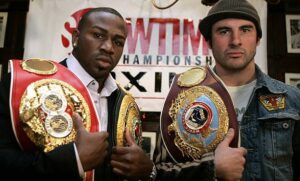
#5 Joe Calzaghe UD12 Jeff Lacy – 04/03/2006
It seems laughable today, but WBO super middleweight champion Joe Calzaghe really was a major underdog when he faced IBF titleholder Jeff Lacy in a 2006 unification bout with the Ring Magazine belt also on the line. Calzaghe had outpointed Chris Eubank for the vacant WBO title back in 1997 and gone on to defend his title an impressive 17 times, but doubts remained due to the questionable quality of challengers and spotty performances.
The Welshman had visited the canvas in recent title defences against Byron Mitchell and Kabary Salem, while a broken hand sustained in his preceding fight against Evans Ashira raised questions over his susceptibility to injury at 34 years of age and many miles on the clock. Meanwhile, Lacy was regarded as a super middleweight Mike Tyson and a man on the rise in the division. The heavily-muscled American was five years younger, boasted 17 knockouts from 21 wins, and his victims included former titleholder Robin Reid, a man who had once pushed Calzaghe to a split decision. In contrast, Lacy had battered Reid to submission inside seven rounds. Boxing heads and bookmakers on both sides of the pond installed Lacy as the clear favourite. Lacy was expected not just to win, but to blow out Calzaghe.
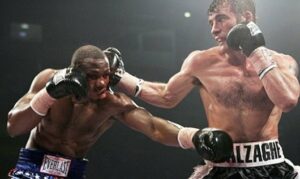
That night in Manchester, what we got instead was the finest performance of Calzaghe’s career as he outworked, outclassed, toyed with and plain beat up Lacy over twelve one-sided rounds. At no point in the bout was Lacy remotely competitive. What punches he did manage to land, Calzaghe shrugged off with contempt. The final punch stats reflected Calzaghe’s dominance as he landed 351 of 948 punches to a paltry 116/444 for Lacy, including a huge final round in which he knocked down Lacy for the first time in his career and had him on the verge of being stopped.
Lacy would never be the same again, looking every inch a shot fighter as he struggled his way to 6-5 in his final 11 contests, taking several more bad beatings in the process. Calzaghe would go on defeat the likes of Mikkel Kessler, Bernard Hopkins and Roy Jones Jr. before retiring as an undefeated world champion, gaining induction into the Boxing Hall of Fame in 2014.
*

#4 Nigel Benn KO10 Gerald McClellan – 25/02/1995
Like Calzaghe, WBC super middleweight titleholder Nigel Benn entered his 1995 fight with Gerald McClellan as a reigning champion fighting on home soil but the clear underdog. The ‘Dark Destroyer’ had defended his title six times but had not demonstrated the same kind of explosive punching power at 168 pounds which had put away durable operators like Doug DeWitt, Iran Barkley and Robbie Sims at 160 pounds. Kronk gym product McClellan on the other hand was seen at the time as the premier pound-for-pound puncher in boxing with an eye-popping 29 KOs from 31 wins as a professional, the majority coming within the opening round. The American had stopped another feared puncher, Julian Jackson, in five rounds to capture the WBC middleweight title. In his final defence before moving up in weight, he rematched Jackson and this time blasted ‘The Hawk’ out within 77 seconds.
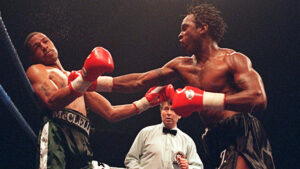
It seemed that Benn was headed for the same fate as McClellan knocked him down heavily and through the ropes in the first round. While Benn had a reputation for a shaky chin – his previous two losses up to that point having come by way of stoppage – his heart and courage could not be denied. Benn fought back as only he could and by the middle rounds had succeeded into turning the contest into an even scrap. McClellan dropped Benn again in the eighth round, but could not put him away. By this time, the American, who had only ever fought as far as the eighth round in his career, was tiring and beginning to exhibit worrying signs of distress, including constantly blinking his eyes. In the tenth round, Benn connected with some heavy blows and McClellan went down to a knee for the first time in the fight. He arose but went down again with little resistance when Benn resumed his attack, this time staying there for the full count.
It was the career-defining victory of Benn’s career, but it was laced by tragedy. McClellan lost consciousness in the ring after the fight and was rushed to hospital. He spent eleven days in a coma and, though he survived, suffered brain damage, heavily-impaired hearing and mobility, and loss of sight, requiring round-the-clock care to this day.
*
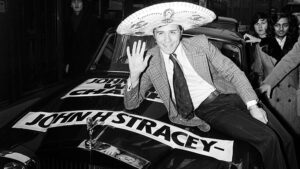
#3 John H Stracey TKO6 José Nápoles – 6/12/1975
José Nápoles is one of the greatest welterweight champions of all time. Born in Cuba, but fighting out of Mexico, the man known as ‘Mantequilla’ was a stylish boxer-puncher who ruled the roost at 147 pounds between 1969 and 1975, defeating standouts such as Curtis Cokes, Emile Griffith, Ernie Lopez and Armando Muñiz. His only defeats in this period came to Billy Backus on cuts, one which he avenged in emphatic fashion in a rematch, and to the legendary Carlos Monzón at middleweight.
In total, Nápoles won 14 unified championship bouts, a record which he shared with Muhammad Ali for many years until overtaken by Wladimir Klitschko in 2015. He entered his final title defence against John H. Stracey with an impressive record of 81-6-0 including 54 knockouts. Londoner Stracey was the European champion and had a highly respectable record of 42-3-1, including a win against former Nápoles victim Lopez, but was still a relative unknown and the major underdog when he squared off with Nápoles in the latter’s adopted Mexico City in December 1975.
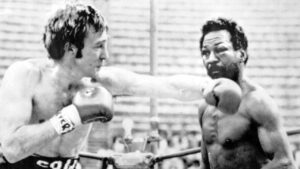
Nápoles knocked down Stracey in the opening round and it seemed like the Englishman was in over his head. Stracey not only recovered, but thereafter took control of the fight as it became clear that the 35 year old Nápoles was no longer the fighter he once was. Stracey kept Nápoles at the end of his jab and peppered him with shots that busted open his face and caused severe swelling, culminating in a one-sided sixth round in which the referee intervened to save the hometown fighter from any further punishment.
Nápoles wisely retired after the fight, resisting the urges of a comeback, and was inducted into the Boxing Hall of Fame in 1990. Stracey demonstrated he was not a one-hit-wonder by defending his title against highly-ranked contender Hedgemon Lewis, before falling to another future hall-of-famer, Carlos Palomino, by knockout in the twelfth round.
*
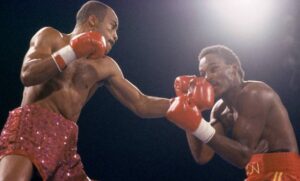
#2 Lloyd Honeyghan TKO6 Donald Curry – 27/09/1986
Heading into his 1987 title defence against the UK’s Lloyd Honeyghan, Donald Curry was widely regarded as the best pound-for-pound boxer in the world. Curry was an outstanding amateur, reportedly only losing 4 of over 400 bouts in the unpaid ranks. As befitting his nickname of the ‘Lone Star Cobra’, Curry was a rangy welterweight with a snake-like jab, dazzling speed, reflexes and fight-ending power; witness the right hand which iced Milton McCrory to capture the undisputed welterweight title in 1985. Curry had also twice bested the excellent Marlon Starling. Both were seem as far superior fighters to Honeyghan, the reigning European, Commonwealth and British champion. Honeyghan was likewise undefeated and had decent wins against Harold Brazier and Gianfranco Rosi on his record, but Curry was seen as being in a class of his own. In the lead-up to the fight, the defending champion famously dismissed Honeyghan as a ‘ragamuffin’, an insult which would come back to haunt him.
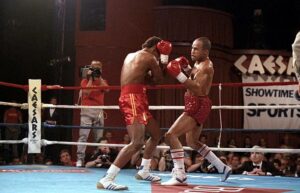
Curry experienced severe difficulties in making weight for the fight, reportedly losing 21 pounds in six and a half weeks before the fight. However, as a big welterweight, Curry had always struggled to make the 147 pound limit. Against a supposedly overmatched opponent like Honeyghan, it was an afterthought for him and his supporters. It turned out to be a big mistake as an inspired Honeyghan, showing zero respect for the champion’s reputation, laid into him from the opening bell and never let up. He nearly dropped Curry with a big right hand in the second round and manhandled him for the rest of the fight. The weight-drained Curry simply did not have the physical strength to stave off Honeyghan’s relentless pressure and by the end of the sixth round he was hanging on; a weary, bloody mess. After a brief discussion with the ringside doctor, Curry’s corner stopped him from coming out for the next round and a jubilant Honeyghan was the new champion.
Honeyhan would thereafter wear the ‘ragamuffin’ moniker with pride, defending the undisputed welterweight championship thrice, all against former and future world champions. He would lose and then regain his belts against Jorge Vaca, before losing them for the final time against a rejuvenated Starling. Curry would go on to win another world championship at junior middleweight, but never recaptured his pre-Honeyghan form. He felt short in his his remaining big fights against Mike McCallum, Michael Nunn and Terry Norris, being stopped by all three.
*
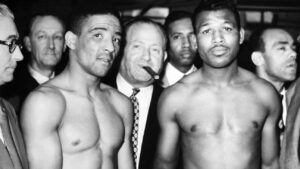
#1 Randolph Turpin 15PTS ‘Sugar’ Ray Robinson – 10/07/1951
Sugar Ray Robinson is, simply put, the greatest boxer of all time. That even Muhammad Ali named him as such should clear up any controversy. Ali is not alone in his assessment. Hordes of fellow boxing icons have likewise named Robinson as the best to ever lace up the gloves. While we do not have the space or scope in this article to highlight the full extent of Robinson’s achievements inside the ring, let’s suffice to say that in 1951 when he defended his world middleweight championship against Randolph Turpin, the 30-year-old Robinson was at the peak of his powers. His professional record stood at 128-1-2 with 84 knockouts; utterly astronomical figures.
Turpin, of Leamington Spa in Warwickshire, was the reigning European champion with a record of 40-2-1. To measure his level of opposition he had faced against Robinson’s level of opposition was however like comparing ground chuck to prime filet mignon. Robinson was on a tour of Europe, disposing of local champions for a series of easy paydays. Some of the money went towards maintaining his entourage which included a trainer, manicurist, driver, 2 hairdressers and even a dwarf to tell him jokes. Turpin was merely the last stop before Robinson returned home; the perfunctory sacrificial lamb. Even the British press derided the matchup, with one newspaper famously including the tagline “You don’t need a referee with Ray. Just a guy who can count to 10!” Robinson arrived at the fight in his trademark pink Cadillac. Turpin took the train down from Leamington to London.
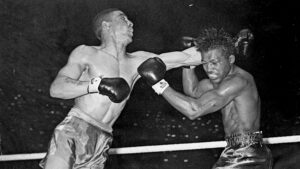
From the start, Robinson had his hands full with the powerful, physically strong Turpin. Unlike Robinson who had started his career at welterweight, Turpin was a natural middleweight and a big one at that. He used his superior size and strength to bully Robinson up close and in the clinch, but demonstrated his underrated boxing ability as well; anticipating Robinson’s moves, countering him effectively and picking him off with a thudding straight left. By round seven, Robinson was cut above the eye. By the late rounds, the cheers of the home crowd were growing as they realised that their man was in control and seemingly full of energy, while Robinson appeared listless and short of ideas on how to solve the puzzle in front of him. By the fifteenth and final round, the champion was staring defeat in the face. Turpin could have played it safe, but not wanting to leave anything to doubt, gave everything he had in the final round, even managing to hurt Robinson before the final bell rang. The result was never in doubt. Turpin was declared the winner by the referee and the ‘Leamington Licker’ had pulled off the biggest upset in British boxing history. He clearly and convincingly defeated the greatest boxer of all time, in his prime, fair and square.
A rematch was quickly arranged, this time in the United States, and Turpin once again put forth a valiant effort, winning most of the rounds and cutting Robinson badly before being caught and stopped in the tenth round. Robinson would have many more memorable nights as part of his storied career, but it was effectively the end for Turpin. His career waned thereafter and post-retirement he fell into deep financial difficulties and depression. He committed suicide by shooting himself in 1966, aged only 38. In spite of Turpin’s tragic ending, he still gets to claim the honour of the greatest win by a British boxer in the sport’s history.
Article by: Paul Lam
Follow Paul on Twitter at: @PaulTheWallLam